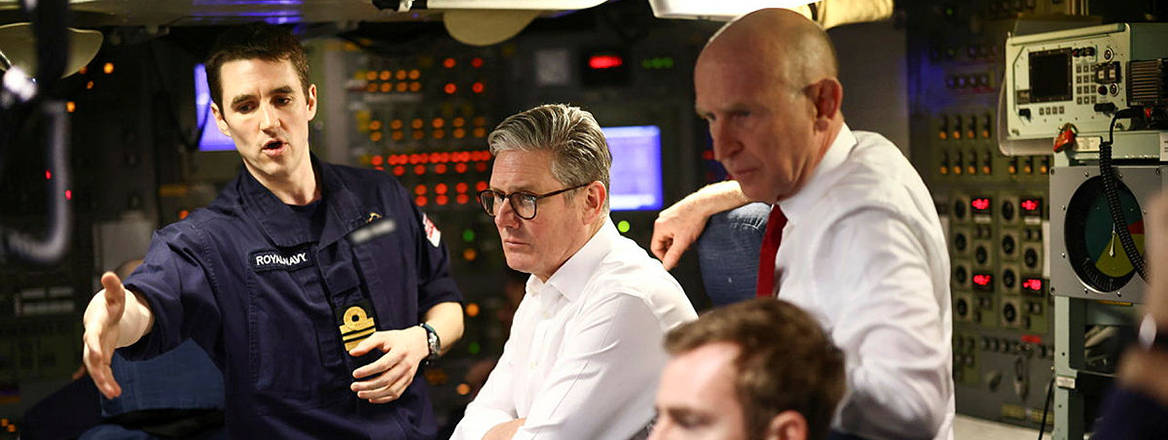The Strategic Defence Review Needs to Retain its Ambitions on Technological Transformation
The long-awaited Strategic Defence Review can lead to significant change in the Armed Forces if it moves beyond previous platitudes and half-implemented ideas on innovation to rebuild the foundations of defence while also making recommendations for the big choices on technological transformation.
The SDR is Released from Purgatory
The much-discussed UK Strategic Defence Review (SDR) has recently been subject to a wearingly familiar succession of leaks and speculation, and now appears likely to be published in the week of 2 June. Through its gestation, the review has been dogged by concerns about delays caused by the changing global context, the level of its ambition, and the extent to which the government’s commitment on spending 2.5% of GDP would be enough to address the issues in Defence.
When the review was in its research phase, a trio of distinguished former UK officials set out a framework against which to judge it. Now the results of the review are imminent, how might it be read, and what should be examined as measures of success or challenge when it eventually sees the public light of day? In particular, how might its level of ambition for the ‘transformation’ of the UK’s Armed Forces be judged?
Schrodinger’s Review
The first area on which to evaluate the review is the manner of its presentation, particularly in its conclusions. The review is unusual in it is notionally independent, delivered by Lord Robertson as part of a trio of senior figures (Dr Fiona Hill and retired General Richard Barrons the other two), alongside a number of external experts and specialists, supported but not directed by a secretariat in the Ministry of Defence (MOD). They had free rein to make suggestions and propose ideas to change Defence, albeit they also have terms of reference – including a budget ceiling – within which to work.
These constrained the review, as did limited capacity (albeit bolstered by artificial intelligence summarising the thousands of submissions), but in the final analysis this should be a review less encumbered than previously by inter-service politics or the orthodoxy of the MOD. However, if media reporting is accurate, we can infer it was largely finished some time ago, but has been delayed until now by wrangling over how to implement it, what this means for the MOD’s finances, and how to present the subsequent work the MOD will need to do.
This was always the danger inherent in picking an independent team but running the review on behalf of the MOD: it could present politically difficult options. It is not feasible to only publish part of it, and cherry-picking will be obvious, leaving the alternative of watering it down. But if the report’s authors are lukewarm over the final results, or step away entirely, it will undermine its intellectual case, and lead to doubt about the government’s seriousness in approaching the issue.
The UK has instead been left with an eclectic mix of the cutting-edge sitting uneasily alongside the obsolete – for which replacements are often late, or, where weapons upgrades lag, new capabilities find their potential limited
A completely independent review would not need government ‘sign-off’ or ‘approval’ from the Treasury. Of course, the Government might not have liked the conclusions, but much like a report from a Select Committee, a government response could have then applied budgetary realism or an alternative perspective and then engaged in the resulting open and (hopefully) educational public debate about priorities. Instead, we are left with something like ‘Schrodinger’s Review’: both independent and dependent at the same time.
Strategy Requires Making Choices and Compromises
The second area for judgement is its utility as a ‘strategic’ document and whether the SDR is trying to be ‘a’ strategy or not. If so, it should be read as an attempt to achieve the cliched but necessary balancing of ‘ends, ways, and means’ for Defence: determining the purpose of the Armed Forces, how they should go about their business, and with what resources (inside a ceiling dictated to the authors).
The signs for this are not positive at the moment, given the previously-mentioned delay for discussions in the interval between the SDR’s conclusion and its publication. The terms for the review talk about prioritisation of objectives, investments and activity, which certainly sounds like important components for a strategy. But more recently, the Permanent Secretary of the MOD appeared to suggest details around investment decisions might not appear until the autumn in a separate, MOD-authored document, not least because the MOD is still trying to work out the shape of the revised Equipment Plan.
To be fair, it would be unreasonable to expect this work to both review all of Defence and perform the function of an MOD Budget Cycle in its totality. But given the challenges to the current structures and capabilities of the military, if it can’t even approach the level of detail of recent reviews in relation to capability choices (e.g. the 2010 and 2015 proposed future forces) then there is a danger it becomes too aspirational to be useful (or more cynically, too vague for the MOD to be held to account against it). We should therefore expect a ‘strategic’ review to be about prioritisation, assumptions and guidance for choices. This is also where it is possible to judge the ambition and scope of the review’s conclusions, particularly on the use of technology.
Money Alone is Not Transformational
This immediately brings up the most obvious cause for any caution about the short-term impact of the review. The spending target of 2.5% of GDP (which we now learn will also include money being spent to ‘lease’ Diego Garcia, albeit as a tiny fraction (0.2%) of the Defence Budget) is not so significant an increase as to be genuinely ‘transformational’ – at least, not given the current state of the Armed Forces. To be transformational, it will need to cut and significantly reshape the Armed Forces by taking risk in some areas to transform others.
The boost of several billion pounds a year should probably first be used to fill gaps: in ammunition and other weapons stockpiles; in infrastructure and housing; logistics and support functions; and in support to personnel conditions, pay and recruitment. To make radical, rather than incremental additions to military capability (for example in order to take advantage of new technologies) will therefore require some big choices on early retirement of capabilities or reductions in numbers.
Defence has been here before in terms of the promise of new capabilities being presaged by the early loss of others due to budget pressure: the cuts of November 2024 were just such a case and given the modest savings made over five years, were an indicator of just how tight in-year finances are at the MOD. Before that, the Integrated Review and related Defence Command Paper both promised investment in ‘advanced technologies’ would improve the forces – after a number of ‘legacy systems’ were cut to make room. We have had years of talk of ‘sunset and sunrise capabilities’ but rather than a planned and managed transition from older forces to new, the UK has instead been left with an eclectic mix of the cutting-edge sitting uneasily alongside the obsolete – for which replacements are often late, or, where weapons upgrades lag, new capabilities find their potential limited. This was not the planned ‘high-low mix’ as part of an ‘integrated force’ we were promised, but a classic British attempt to muddle through.
Implementation Needs to Move Beyond Experimentation
It is here the SDR could make a major mark. Never mind quibbling over the sufficiency of the 148 Challenger 3 tanks the UK will eventually have by 2030: given the experience of Ukraine does the SDR believe tanks have a future as currently envisaged? Are the Army’s expensive attack helicopters still worth it in a world where the front line is increasingly dominated by drone threats? If, as reported, the Navy wants to radically increase the number of uncrewed vessels for a variety of tasks, should it still be developing large surface combatants, and what role is envisaged for the aircraft carriers? And in air and space, might future surveillance capabilities be better provided by stealthy drones and space-based sensors rather than large, slow, vulnerable crewed aircraft such as the E-7 Wedgetail?
The SDR could help by making clear where the big bets could be made on technology – and where cold water needs to be poured on ideas that represent a triumph of optimism over reality
The UK has talked a good game on experimentation and trials, including on artificial intelligence (AI) and directed-energy weapons, but these have yet to translate into large-scale production of any new capabilities operating outside of niche organisations. New processes and structures such as a Defence Innovation Unit, and an Integrated Procurement Model are being introduced, but will take time to show their worth: the MOD already had an innovation unit alongside other innovation centres, and the IPM’s acceleration of the DragonFire laser weapon came after it had already spent seven years being developed. At least the recent announcement of the new StormShroud drone coming into service represents the first major implementation of the RAF’s Autonomous Collaborative Platforms Strategy and is a significant improvement on the RAF’s over-hyped ‘drone squadron’ which spent several years without conducting a drone trial.
Ambitious Targets for Change Are Needed
The SDR could help by making clear where the big bets could be made on technology – and where cold water needs to be poured on ideas that represent a triumph of optimism over reality. It could identify where ‘legacy’ items have outlived their usefulness and where technological solutions will enhance existing capabilities.
Moreover, it should identify where mass and depth remain vital to the creation of effective fighting power: the inexorable reduction of force sizes combined with the increasing cost of systems is unsustainable.
Some advice on where either the expansion of forces and stockpiles are required, or acceptance of limitations will be necessary alongside collaboration with allies and partners. On this last point, there should be some consideration of how to survive friction in the critical relationship with the US; a complete break is in neither’s interests, and tremendously expensive but given the unique extent of the UK’s intertwining with the US military – and thus its vulnerabilities – some additional insulation is required if the US is less reliable or (not unreasonably) expects a more prominent role for Europe in its own security.
To do all this it may be necessary to set ambitious, and crucially, measurable targets. For example, what proportion of RAF combat aircraft should be uncrewed and by what year should this target be achieved? What functions in the Royal Navy should be handed over to remote or autonomous systems, and by when? The Army has reportedly already identified a target for the proportion of its combat power to be provided by traditional crewed capabilities (20%), reusable uncrewed capabilities (40%), and disposable drones (40%). But it is not yet clear how this metric is calculated, and it is hard to believe the first category will only comprise a fifth of total budget or firepower.
Targets matter: although similar targets in the US have been missed, as has been pointed out, the fact they existed created a benchmark against which some aspects of modernisation could be measured
Other goals could be about testing the Defence Secretary’s claim that the UK will be at the leading edge of innovation on AI; for example, the widescale adoption of AI to complete all initial analysis of imagery, thus accelerating intelligence analysis, or the use of software to do initial operational estimates.
Targets matter: although similar targets in the US have been missed, as has been pointed out, the fact they existed created a benchmark against which some aspects of modernisation could be measured. The statement by the Chief of the General Staff that he intends to double the Army’s combat power within three years is exactly the sort of target that focusses minds and could potentially be useful if they appear in the SDR, and can be measured (in this case defined as a brigade being capable of defeating a Russian Combined Arms Army).
And if the MOD disagrees with these, for example, because it has a different understanding of the risks, or the speed at which technology might develop, then it should be asked to set out its own analysis, such as the probability AI smarter than people (Artificial General Intelligence) will arrive, the point at which this becomes more likely than not, and if never then why. The briefing this week that the MOD will develop a ‘Digital Targeting Web’ to be in service in 2027 is a decent start, though if it is learning lessons from what Ukraine has been doing since 2022, and uses technology already available, is this fast enough?
None of this is to suggest the SDR should purely focus on being a technologist’s manifesto. It also needs to make judgements on the state of the UK’s industrial base, and effective use of the UK’s reserves, amongst many other issues. We have not even mentioned the expense of the nuclear deterrent, its longevity and other options to improve deterrence in Europe. But many of the developments in UK Defence since the end of the Cold War have inevitably justified shrinking forces on the back of more advanced capabilities. Given we are now seeing the speed of adaptation and counter-measures in the war in Ukraine, it is reasonable to ask how this review will cut through the hype and myths and make concrete recommendations, using its independence to force change at a pace the MOD has been unable to demonstrate on its own.
© RUSI, 2025.
The views expressed in this Commentary are the author's, and do not represent those of RUSI or any other institution.
For terms of use, see Website Terms and Conditions of Use.
Have an idea for a Commentary you'd like to write for us? Send a short pitch to commentaries@rusi.org and we'll get back to you if it fits into our research interests. View full guidelines for contributors.
WRITTEN BY
Matthew Savill
Director of Military Sciences
Military Sciences
- Jim McLeanMedia Relations Manager+44 (0)7917 373 069JimMc@rusi.org




